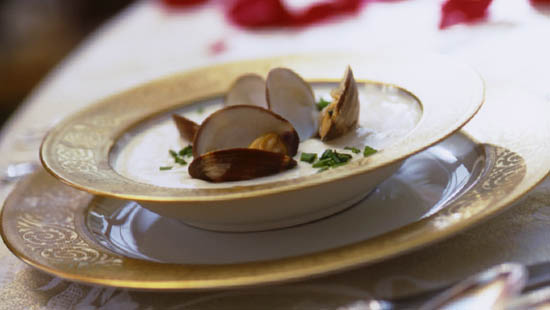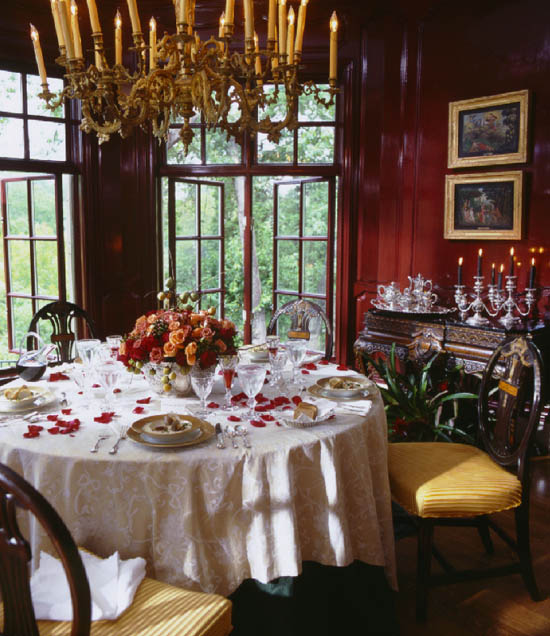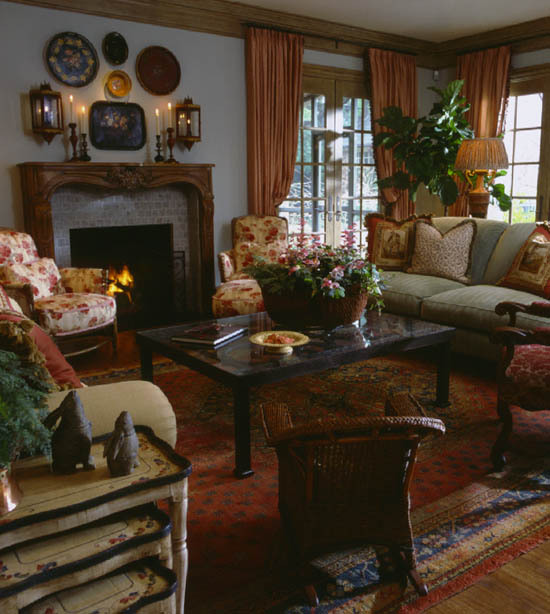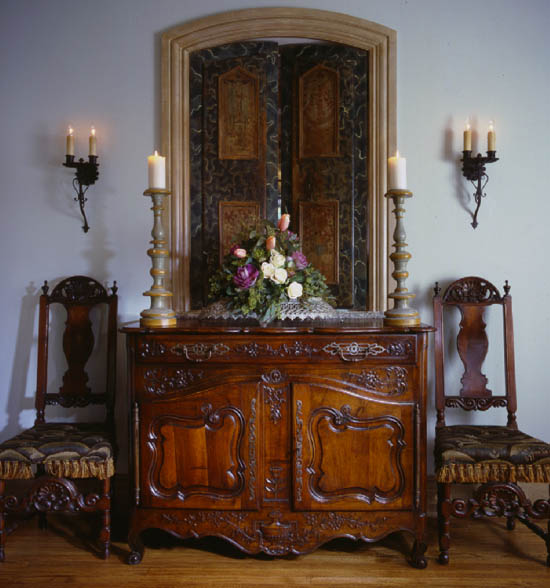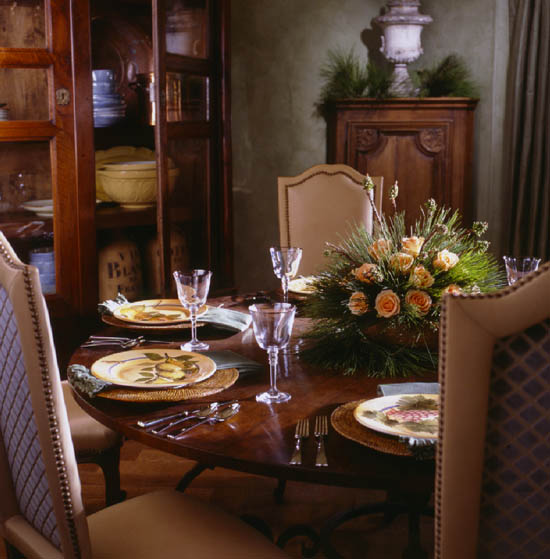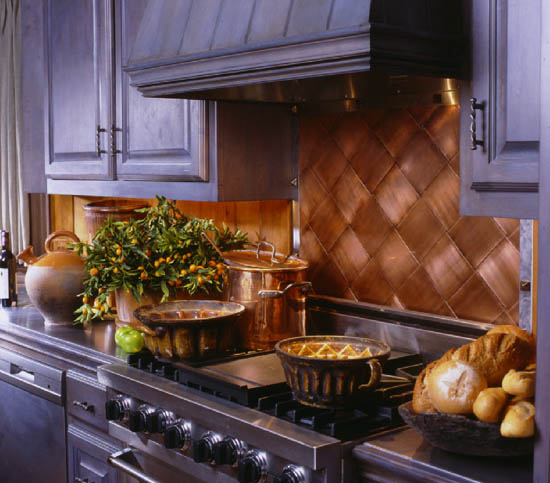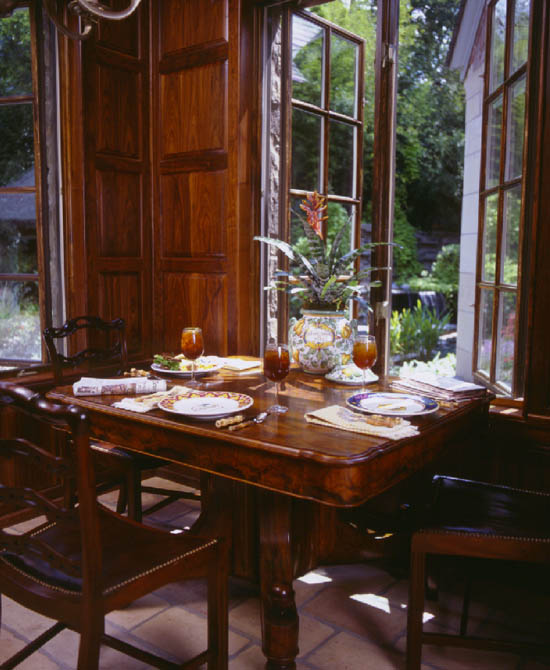Simplicity, carried to an extreme, becomes elegance.
In the discriminating world of interior design, France and Italy have forever commanded respect, setting standards of excellence with their fine furniture, regal array of textiles, and papiers peints, or painted wallpapers. Also enrapturing an international roster of admirers for some years now are the treasured tapestries, distinctive porcelains, stunning crystal, and delicate embroidered linens about which the people of these nations rightly boast.
As it happens, even proud Americans readily concede that the French and Italians have an edge when it comes to creating artful, elegant interiors with the aura of romance and glamour. For centuries, Italy was the undisputed arbiter of taste and style—deeply rooted in the region’s vulnerable history of invasions by the Austrians, French, and Spanish, who each left an imprint of their customs and ways of living after claiming this picturesque land as their own.
Milan and Florence, for example, fell under the rule of France, while Sicily and Naples were ruled by Spain; Venice was controlled by Austria until the nineteenth century. From a network of duchies, principalities, and independent city-states, the Republic of Italy was created on March 17, 1861, with Turin as the capital. For political reasons, the center of government was moved to Florence in 1866, and finally Rome was declared the capital in 1871, a year after being conquered.
Distinct regional styles had emerged during the Middle Ages (1000–1450) after the Romans destroyed much of Italy’s earlier Etruscan culture, whose exquisite gold and bronze metalwork was influenced by the Greeks. The Romans, too, borrowed elements from the Greeks; however, it was their own effective technological advances and skillful engineering that made it possible to span spaces with arched corridors, vaulted ceilings, and rounded domes. Since then, their influence in Europe and the West has remained indisputable.
John Notman, who emigrated from Scotland in 1831, is universally credited with introducing the Italianate villa to the United States. In 1839, he designed Riverside, a private residence in Burlington, New Jersey, that might have been transported from Tuscany. To the dismay of historic preservationists, it was razed in 1961. Nearby, however, the much-photographed Prospect mansion, built in 1851 at the center of Princeton’s campus, stands in testament to the architect’s love for Italy.
Indifferent to changing times, villas, palazzi, châteaux, and hôtels particuliers on sprawling European estates resound with the refined elegance of centuries-old furniture, expertly woven fabrics, and Aubusson carpets unfurled under aristocratic feet. Of course, not everyone lives in such imposing architectural grandeur meticulously dressed. Barely 25 percent of Parisians live in houses, while in tidy smaller French hamlets, 75 percent of the people dwell in single-family homes within a stone’s throw of each other.
Similarly, in scattered Italian cities, families often inhabit palazzi bearing their nation’s storied past that have been converted into intimate, airy apartments with lofty doors opening wide onto balconies fringed with flowers. Frankly, owning palatial havens with chilly halls, flaking plaster, hefty maintenance fees, and long-ignored grounds simply does not appeal to the sensibilities of many French and Italian aristocrats, or even to those the French call the jeunesse dorée —the young and moneyed—a more relaxed privileged generation. They see the size of a house as less important than its furnishings and the way those pieces mirror the life within. For them, there is no signature look any more than there is one distinctive way to live. There is, however, a classic approach to space planning—guided by intelligence, awareness, and panache. It is a given that furnishings should be the best one can afford, testifying to one’s impeccable taste while discreetly offering a window into one’s soul.
Tellingly, then, spaces are chicly rendered works of art, exuding a passion for beauty, an intuitive sense of scale, harmony of color, and reflection of one’s inner self. Marrying old-world craftsmanship with an audacious mix of treasures handed down from caring ancestors, settings look as if they’ve been furnished at an unhurried pace by several generations of family who had explicit ideas on style.
Massive portraits, sculpture, cherished books, and other enviable links to bygone eras holding court hundreds of years later offer the reassuring feeling of the familiar, and somehow make grand, pleasingly proportioned rooms appear even grander. It is not enough, however, for quarters to brim with prized objects displayed like museum artifacts. Ultimately, convention dictates that possessions must reveal interesting aspects of versatile lives as well as represent the culture of those exhibiting them.
As a result, humble antiques mingle graciously with more important pieces, relaxing formality and balancing the splendor of rooms. Masterfully cut and flawlessly tailored window treatments brush the floor with soft braid or fringe trimming drizzled from pencil-thin piped edging. A stream of perfectly matched stripes, florals, and storied toiles affectionately hug upholstery, though in less dressy spaces seamstress tucks often nestle amid shapely slipcovers as unassuming seagrass offhandedly blankets well-traveled floors.
Everywhere you look there are blooms of cascading flowers suiting the spirit of striking, interestingly textured rooms. With neither the French nor the Italians inclined to compromise their standards, Porthault and Frette linens—fashioned of Egyptian cotton in France and Italy, respectively—are spritzed with scented water, making beds romantically inviting. En suite, enough thick, fluffy towels to comfortably stock Paris’s legendary Hôtel Ritz or the princely sixteenth-century Villa d’Este, which sits on the banks of Italy’s Lake Como outside Milan, soak up centuries of history.
Traditional Italian kitchens appear tidy, orderly, and clutter-free. With a place for everything and everything in its place when not in use, spring-latched cupboard doors mask precisely stacked molds, various-sized mixing bowls, colanders, and metal cauldrons. Fruits and vegetables not requiring refrigeration sit in small metal boxes on balconies until called upon to express regional preferences.
Meanwhile, practicality holds sway in French kitchens, where baskets for storing crusty breads and scores of copper pots in graduating sizes crowd ceilings, proudly hanging out within easy reach on pot racks, or crémaillères, which are almost as integral in the French kitchen as cross-timbers and weathered walls.
Most kitchens in France do not have upper cabinets. Rather, open shelving allows ready access to la batterie de cuisine —pitchers, platters, goblets, tureens, and any other items needed. Countertops burst with dozens of utensils for every imaginable purpose, while colorful faïence (pottery with luminous glazes), heavy Continental-size flatware, and bowls of apples garnish tables set on terra-cotta tile betraying its age.
In contrast, when the Mediterranean sun sinks into the horizon, dining rooms sparkle like diamonds—impeccably set—as glistening silver, breathtaking crystal, and a regal mix of delicate china showcase culinary talents.
For serious cooks, cuisine is more than a means to satisfy the pangs of hunger; it is rather a theatrical production, inventively propped, perfectly staged, and, most importantly, designed to elicit applause. Accordingly, candlelight swirls over flavors and aromas needing little introduction, highlighting dramatically the link between how food looks and the architectural manner in which it is presented.
In France, the expression epater le bourgeois means “to astonish them”—and the French have more than risen to the challenge of bracing occasions with this attitude. Whether a casual breakfast, a picnic lunch, an afternoon tea or a leisurely dinner à deux, nothing escapes attention. Service plates are noticeably liberal in size, goblets gleam, and linens appear crisp, having been painstakingly pressed. Masses of the same cut flower, assembled with a French touch—tightly packed and equal in height—look obligingly unarranged.
Indeed, the French fervor for fine food is expected to start early. In France’s école maternelle, three-year-olds bake pies. For one week each year, the French also use their gastronomic know-how to teach their children how to appreciate fine food and wine.
Leaving little to chance, some three thousand chefs sweep through classrooms throughout the country, talking about taste, flavor, and discussing the anatomy of the tongue before taking students on a cook’s tour of outdoor markets where they learn to carefully choose the pick of the crop.
With a lot to learn about what to do, and what not to do, no child’s education is considered complete without help in demystifying fine dining. Predictably, then, chefs stir up regional dishes masterminded by fancy restaurants that have garnered Michelin stars, the hospitality industry’s most coveted honor. By revealing secrets of their country’s culinary excellence, the art of French living is passed from one generation to another.
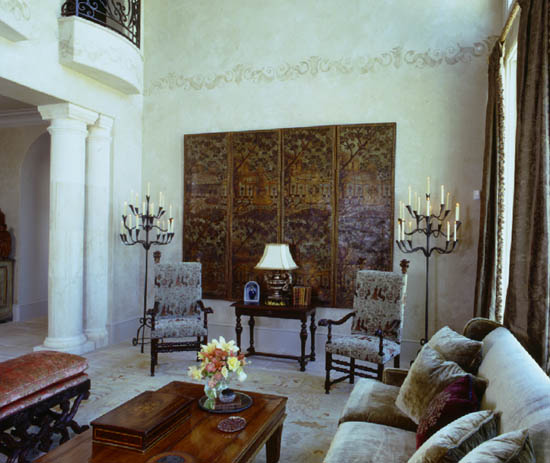
Architectural grandeur enhances the luxurious feeling of a villa salotto with a restrained color palette and impressive pieces from eras past. The well-traveled, hand-tooled leather screen, dating from the eighteenth century, arrived in Houston from Italy—following a respite at Suzanne Golden Antiques in New York. Chairs from nineteenth-century Spain wear a hand-embroidered Rentmeister chenille. The Dessin Fournier coffee table is American made.
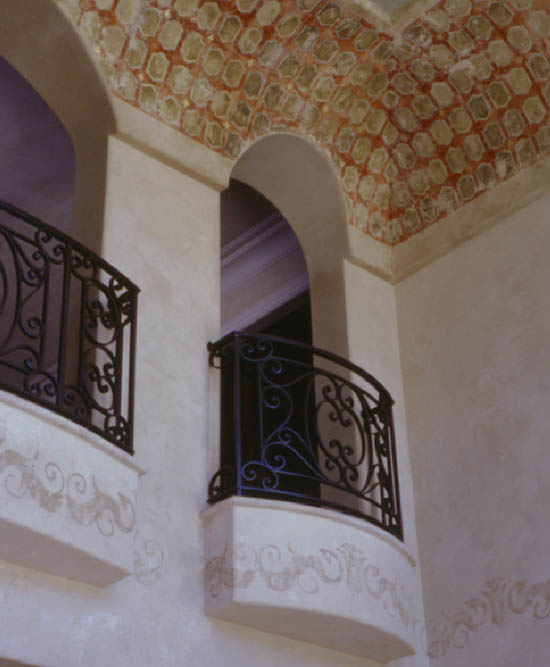
Impeccably crafted balconies look over a lofty salotto, which in Italy is where people visit. The room’s generous proportions are warmed by decorative techniques—stenciling, glazing, and faux finishing—that became popular during the Italian Renaissance. In collaboration with designer John Kidd, artist Rusty Arena brought harmony to the space.
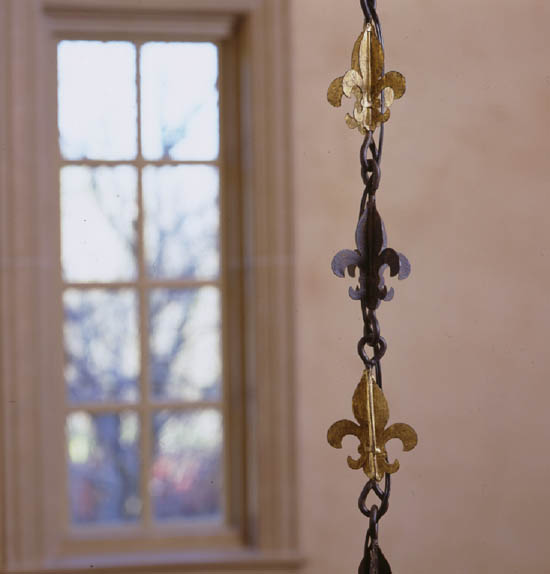
Intrigued by the beauty of the fleur-de-lis, France’s heraldic symbol of unity and harmony, Dallas designer Deborah Walker incorporated the motif in a chandelier chain to complement the home’s French architecture.
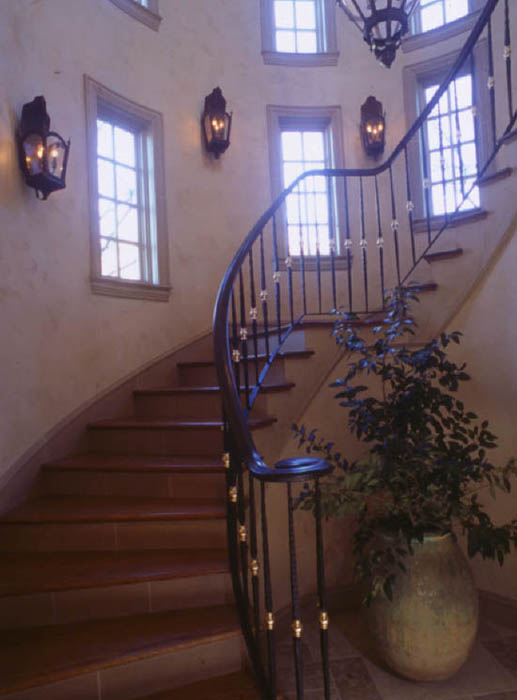
Windows bathe a stairway in light. The olive jar is an antique.
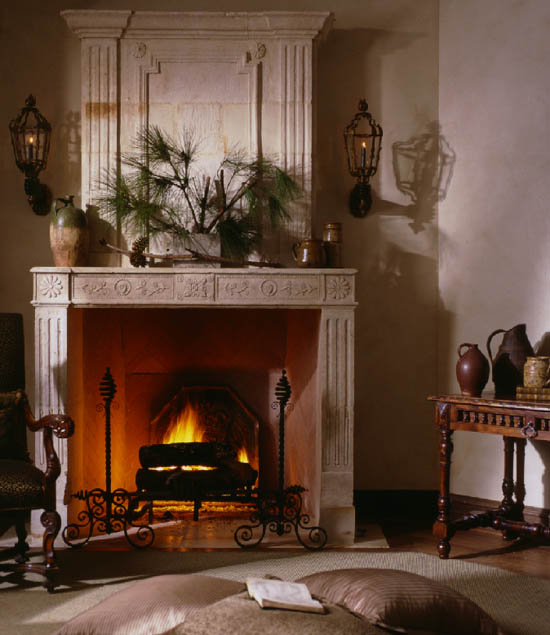
Another view of the room pictured below, this one features the antique stone chimneypiece—an ornamental structure surrounding the fireplace opening—with a patina that is impossible to reproduce. The antique tapestry, desk, and chimneypiece were all French finds.

Simplicity is key to a sophisticated yet no-fuss, family-friendly room. The sofa is covered in Marvic Textiles and chairs with slits in their skirts boast Brunschwig & Fils, while tape culled from Clarence House adds further interest. References to the past also abound: the bookcase, coffee table, and wine table are all antiques, unearthed during a stay in France.
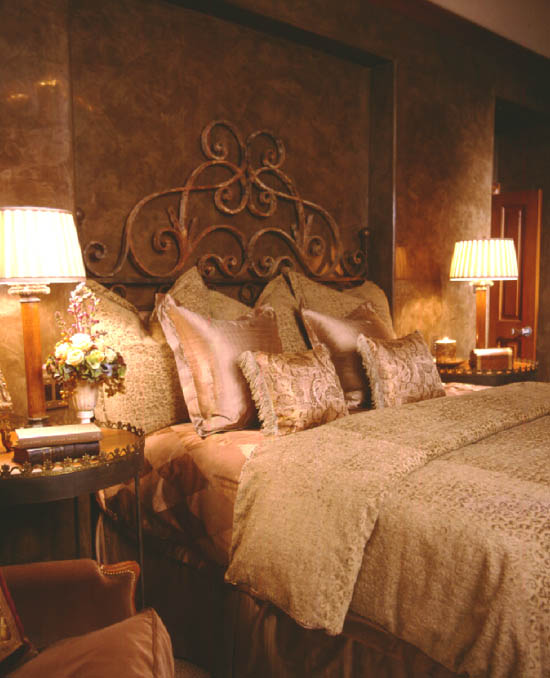
Soothing neutrals and an enduring passion for history give a master bedroom the layered look that usually comes with time. Night tables, lamps, and the iron bed were bought in Paris. Turning an old iron gate into a headboard was a task that fell to Potter Art Metal in Dallas. The Nancy Corzine harlequin fabric, like other fabrics in the room, required careful matching of patterns. Glowing Venetian plaster walls also were labor intensive, as one would expect.

This unpretentious antique, purchased in Paris, offers a less-conventional spot to stock fresh towels and keep sponges, soaps, and lotions close at hand. The master-bath floor is laid in a rhythmic pattern.

Sophisticated Europeans have long had an abiding love for tapestries. In the late fifteenth century, the aristocracy used them to insulate damp walls of their châteaux and castles. Though America is a much younger country, we too have a passion for works of art, such as the historic French-loomed wall hanging, circa 1900. A 35-foot-wide Miró tapestry hung in the World Trade Center until destroyed on September 11, 2001.
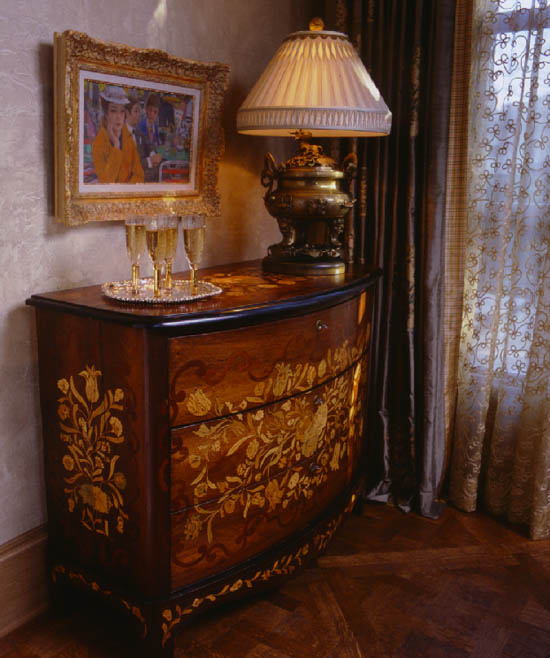
Against gently colored textured walls stands an eighteenth-century rosewood commode that exudes a quiet richness. To create a marqueterie pattern, contrasting materials are set into a veneered surface.
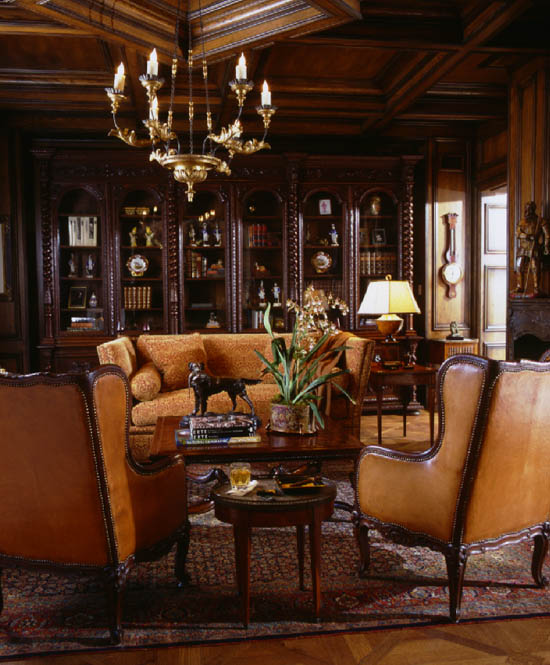
Traversing time zones and connecting continents, a library resplendent in oak paneling assuredly casts its own light on the world. A porcelain collection of Napoléon Bonaparte’s generals rests in the nineteenth-century bibliothéque. Sprawled on the oak parquet de Versailles floor is an antique Tabriz rug, another find from the Renaissance Collection in Dallas.
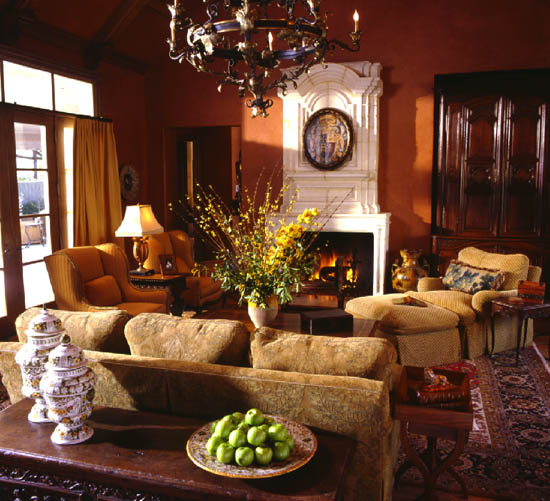
A family room pays homage to fine antiques while displaying a less assuming style than that associated with the Sun King, Louis XIV. Anchoring the room is an antique Persian Tabriz from the Renaissance Collection, Dallas. French countryside finds, including the Régence fireplace and the eighteenth-century buffet à deux corps, reflect the owners’ worldliness.
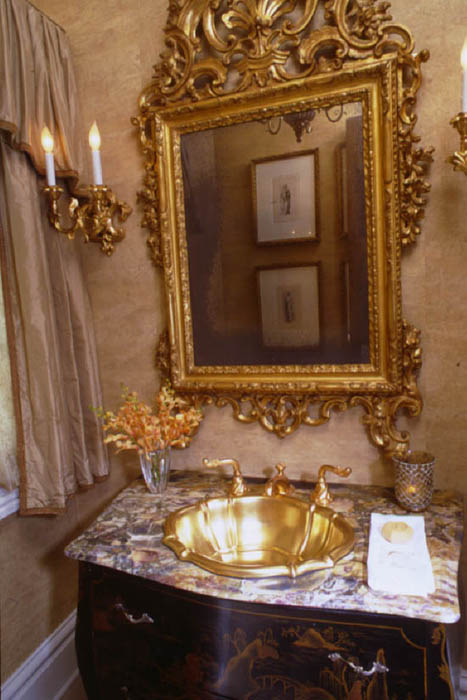
In seventeenth-century France, chinoiserie became the rage, so it’s only natural that a retrofitted commode with nature delicately illustrated would take center stage in a guest powder room. Aside from geometric themes, pagodas, people, and birds are common Oriental motifs. The mirror, from a Paris dealer in the Marché Biron, adds glamour.
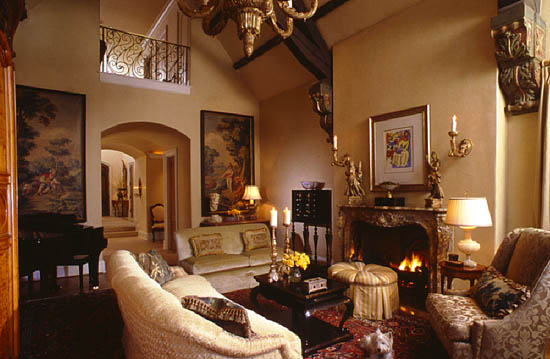
A sophisticated mix of furnishings shapes a salon with architectural presence to spare. The corbels (brackets supporting beams) are eighteenth-century Italian, as is the pietra dura (mosaic marble inlay) cabinet found on Via Maggio in Florence. The console is period Régence. Above it and across the way hang “cartoons”—renderings created before tapestries were woven. If the stories that abound are to be believed, weavers wandered from place to place, settling temporarily in the château, church, or monastery, where they would receive a commission after presenting detailed drawings that later served as the guide for chosen designs. The Persian rug, in the Bakhtiari pattern, is an antique from the Renaissance Collection, Dallas.
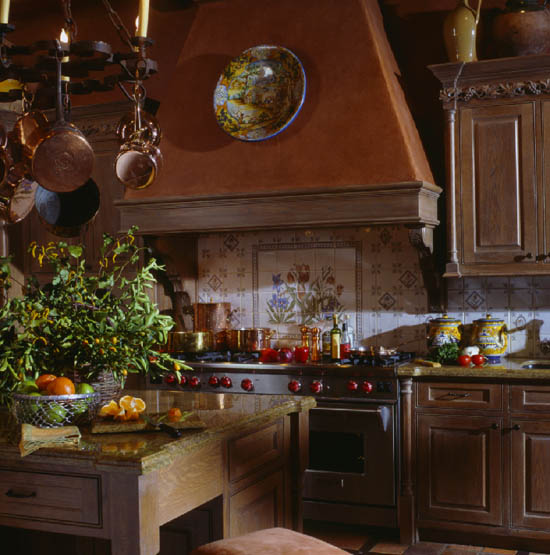
Garnishes of French, Italian, Portuguese, and Turkish descent bestow an international flavor on a villa kitchen where copper—a natural conductor of heat—sways conveniently from a pot rack, ready to satisfy an appetite for pain au chocolat. With its old-world charm, the Village St.-Paul in Paris’s fourth arrondissement is one of the best places to recapture the spirit of another era.
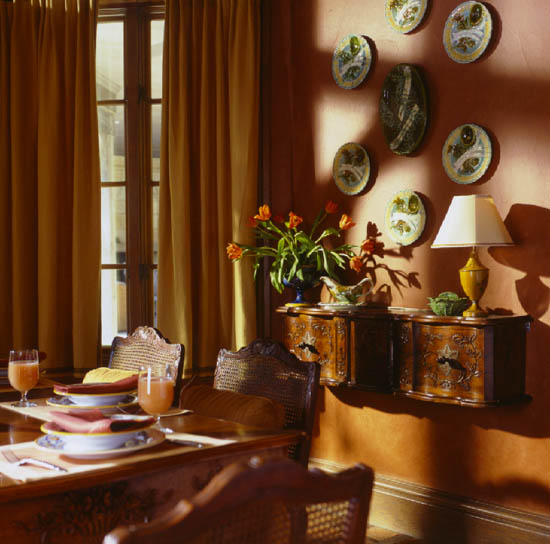
Crisscrossing the ocean shores up a breakfast room with a wave of fine antiques. Régence chairs—from the Marché aux Puces, outside Paris—are period. The set of hand-painted asparagus plates boasts the crackle finish characteristic of handmade Majolica, dating back to the thirteenth century when Italian artisans first adopted this craft from Moorish potters. The glissant (sliding panel) is an example of the Provençal cabinetmaker’s artistry. Sliding panels—with a small tabernacle, or door, between—are designed for storing tableware without disturbing items on the buffet traditionally set beneath it. The table in the style of Louis XV is from Country French Interiors, Dallas.

Fashionably exposed beams and imported Portuguese tile garnish a country kitchen stocked with stained, glazed, and dry-brushed cabinets. The chandelier is from Ironies in Berkeley, California. The faïence was culled from flea markets.
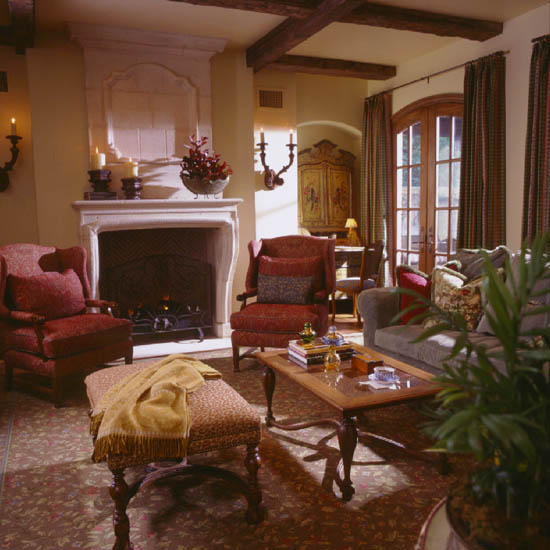
To this day the eighteenth century is thought the most elegant era in European history. It was common for villas of the aristocracy to employ attendants responsible for maintaining and repairing upholstery, and textiles were woven to cover a specific piece of furniture. Here, fabrics from Scalamandré, Cowtan & Tout, and Fonthill preside over a family room where the living is easy.

Nowhere is historic hand-painted furniture more popular than in Italy. A secrétaire cleverly outfitted with secret drawers for storing love letters and niches to hold stationery reflects the eighteenth-century practice of hand-delivering notes. The curtain fabric is from LeeJofa.
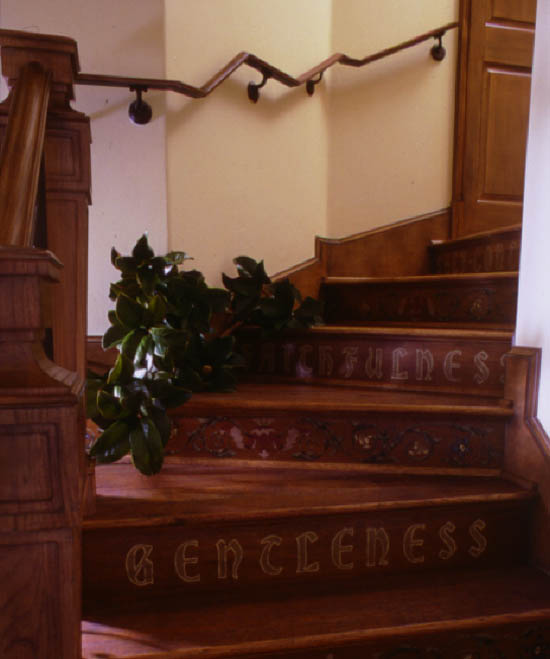
Galatians 5:22 offers a gentle reminder that Spirit is love, joy, peace, patience, kindness, goodness, faithfulness, gentleness, and self-control.
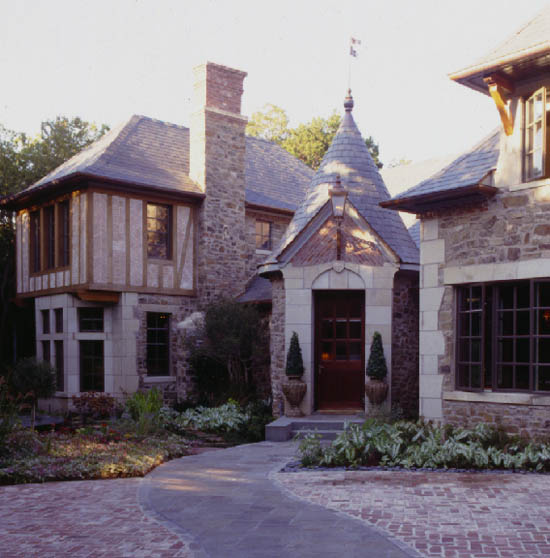
A medieval manoir in the Pays d’Auge région—a verdant province of Normandy—inspired a timber and brick dwelling built recently in the States. Like the typical Norman roofline, this one is steeply pitched, not only making the house aesthetically charming but also facilitating drainage when it rains. The Cuban mahogany front door once graced a school in England.
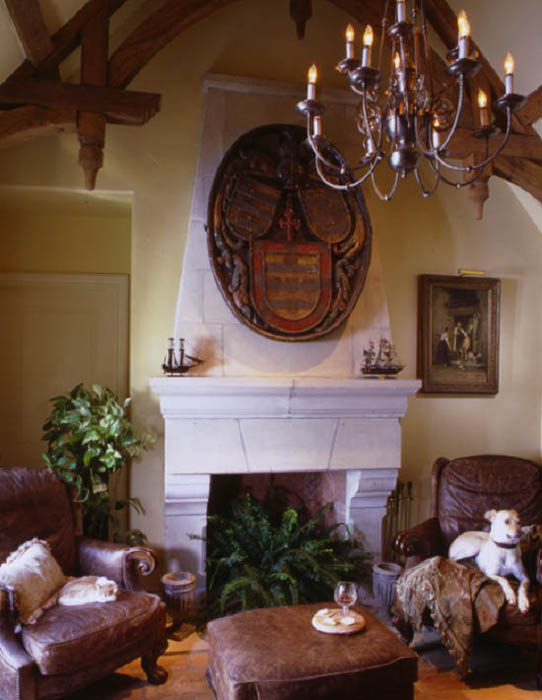
An earthy palette, vintage leather chairs, and tattered pieces of history create an inviting sitting room off the kitchen where friends may gather to keep the cook company. Most often, however, it is the perfect spot to savor an early morning café au lait à deux and peruse the morning papers, then discuss world issues at the end of the day. In seventeenth-century Spain, the carved wooden shield hung in the back of a church; its coat of arms represented three families serving as protectors and benefactors.
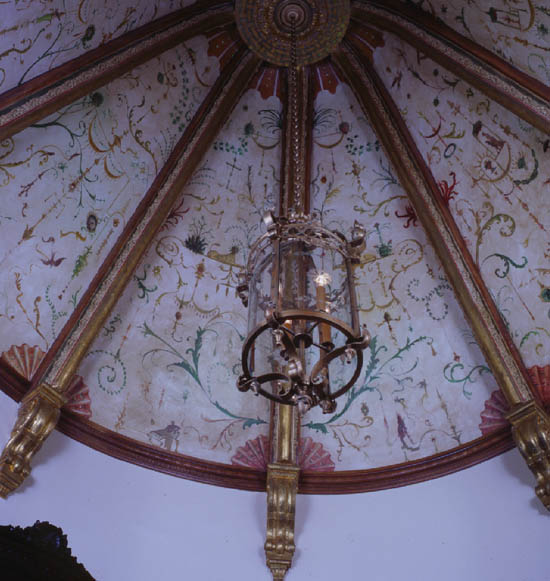
Old-world opulence reigns in an entrance hall whose intricately hand-painted ceiling was inspired by the chapel in Le Lude, the imposing thirteenth-century château standing on an elevated bank of the Loire, France’s longest river. Artist Dan Pedigo lives in Dallas, Texas.
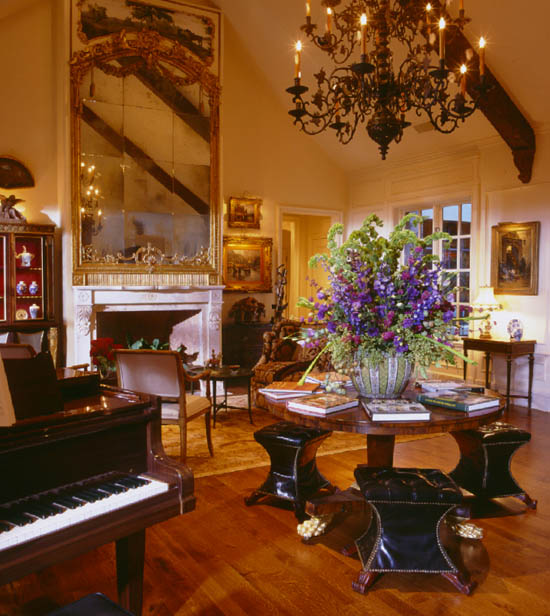
Staking claim to the air space over the great room is an eighteenth-century bronze Russian chandelier thought to have hung in a Kremlin church. Some say the antique August Forster piano, from East Germany, is the finest piano made. It was bought in Paris after the fall of the Berlin Wall. The nineteenth-century French Empire breakfront is rosewood and in keeping with the space’s grand proportions. Both paintings are by Frenchman Edouard Cortes (1882–1969).
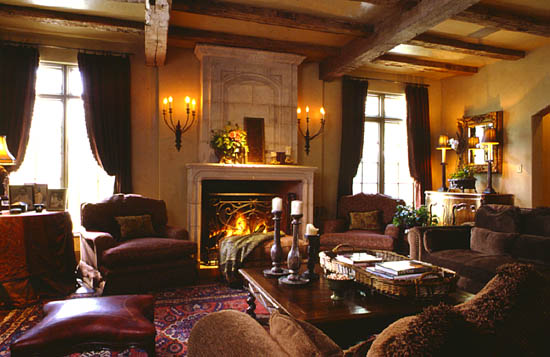
Handsome furnishings honor Louis XV. Family room chairs are robed in Pindler & Pindler while curtains and sofas are clad in LeeJofa, one of America’s oldest fabric houses, established in 1832. The skirted table is draped in vintage Fortuny. Mariano Fortuny (1871–1949) was born in Granada, Spain. He studied chemistry in Germany and sculpture with Rodin in Paris before starting the impressive design house.

A dining room layered in French history offers a visual feast, tempting guests with treasures holding closely guarded secrets. Both the antique velvet screen and the vintage table runners are from The Mews, Dallas. Curtain fabric is by Randolph & Hein; trim is Schumacher. Dining tables were uncommon until the time of Louis XVI.
